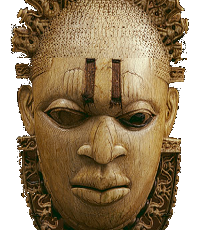Walls and bronzes of Benin
The kingdom of Benin was one of the city-states in the delta created by the Niger river in today’s Nigeria. The people of Benin grew rich from trade, not least in slaves, which they were happy to sell to the Europeans who began arriving here in the sixteenth-century. The state of Benin was surrounded by an enormous set of walls and moats, known as iya, constructed between the ninth and the fifteenth-centuries CE. The walls could be as high as ten meters and the moats just as deep. They had a combined length of some 16,000 kilometers, making it one of the largest construction projects on earth. Other city-states embarked on similar constructions. In the kingdom of Ijebu, a noblewoman, Sungbo, commissioned a wall/moat construction which bears her name to this day. Archaeologists have compared the walls of Benin to the Great Wall of China and complained that the former construction has received none of the attention lavished on the latter. [Read more: “The Great Wall of China does not exist“] It is not quite clear why the walls and moats were built. A project of this scale is difficult to explain as purely a military arrangement. Perhaps it was rather a question of politics – of establishing the oba’s claims to a land and demonstrating to others the extent of their power. In the competitive environment formed by the Yoruba city-states, wall/moat constructions may have been one of the ways in which the oba establish his status.
There is a remarkable collection of bronze sculptures and plaques – altogether some one thousand objects – cast in Benin from the thirteenth century onward. The metal was actually imported from Europe but they were made by local craftsmen using local techniques. The bronzes, which used to decorate the oba’s palace, show the life of the court and the opulent lifestyle of its rulers. They also portray European merchants – the Europeans appear as small figures in the background, wearing odd-looking hats. The bronzes were looted by the British when they occupied Benin in 1897 and were later sold to museums around the world. Many of them are now on display in the British Museum.
External links
- Akin Ogundiran, “Patrick J. Darling (1945-2016)”
- BBC Artbeat: Bronze in Benin City
- BBC News, “Legends of Nigeria’s forgotten monuments”
- British Museum, “Benin plaques”
- Come to Nigeria, “Sungbo Eredo – Yoruba Lost City And Nigeria’s Hidden Wonder”
- Edo Delta Movement, “Benin moats”
- Fred Pearce, “The African Queen,” The New Scientist
- New York Times, “Eredo Journal; A Wall, a Moat, Behold! A Lost Yoruba Kingdom”
- Nigeria News, “Archaeologists find clues to Queen of Sheba in Nigeria, Find May Rival Egypts’s Pyramids”
- Staffan Lundén, Displaying Loot: The Benin objects and the British Museum
- The Guardian, “Benin City, the mighty medieval capital now lost without trace”
- Unesco, “Benin Iya / Sungbo’ s Eredo”
- WorldHum, “The lost world of Nigeria”

